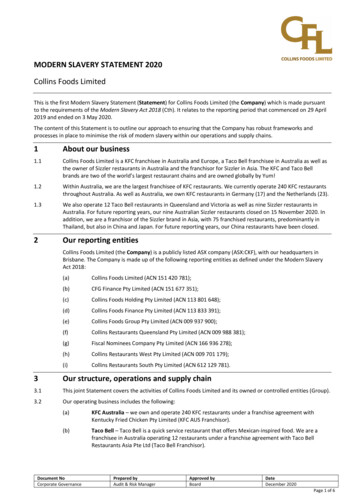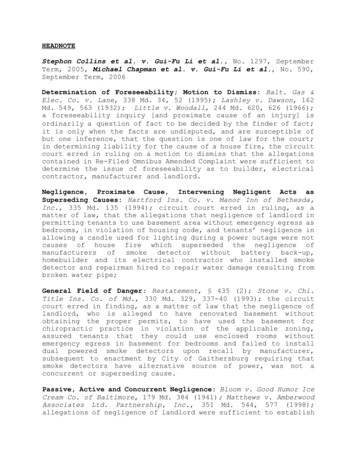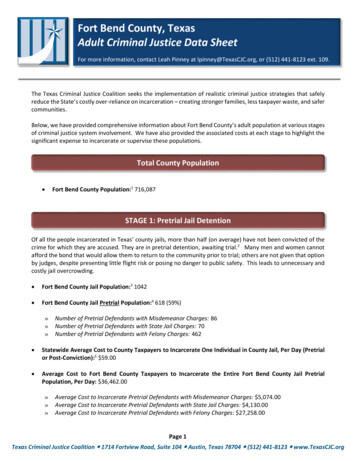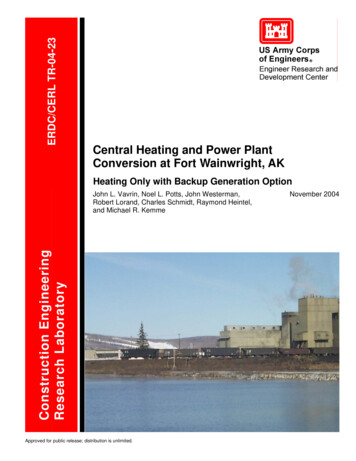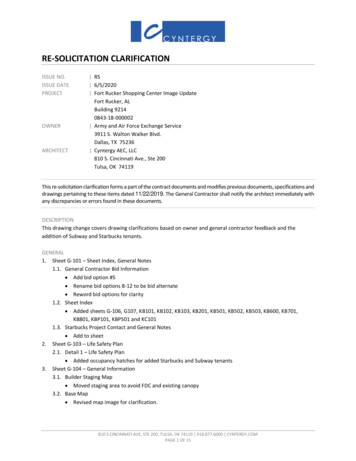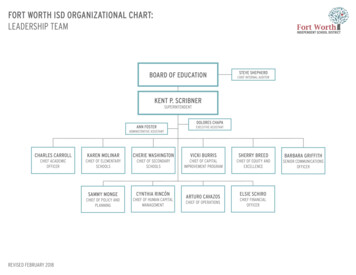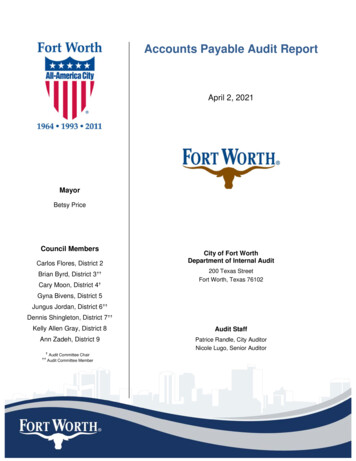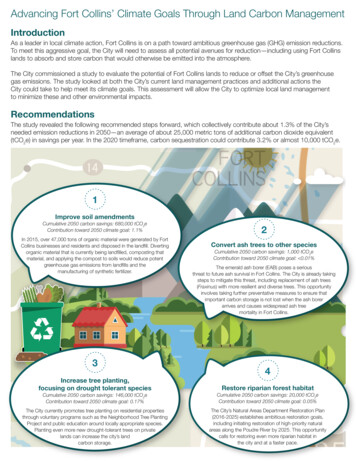
Transcription
Advancing Fort Collins’ Climate Goals Through Land Carbon ManagementIntroductionAs a leader in local climate action, Fort Collins is on a path toward ambitious greenhouse gas (GHG) emission reductions.To meet this aggressive goal, the City will need to assess all potential avenues for reduction—including using Fort Collinslands to absorb and store carbon that would otherwise be emitted into the atmosphere.The City commissioned a study to evaluate the potential of Fort Collins lands to reduce or offset the City’s greenhousegas emissions. The study looked at both the City’s current land management practices and additional actions theCity could take to help meet its climate goals. This assessment will allow the City to optimize local land managementto minimize these and other environmental impacts.RecommendationsThe study revealed the following recommended steps forward, which collectively contribute about 1.3% of the City’sneeded emission reductions in 2050—an average of about 25,000 metric tons of additional carbon dioxide equivalent(tCO2e) in savings per year. In the 2020 timeframe, carbon sequestration could contribute 3.2% or almost 10,000 tCO2e.1Improve soil amendmentsCumulative 2050 carbon savings: 680,000 tCO2eContribution toward 2050 climate goal: 1.1%In 2015, over 47,000 tons of organic material were generated by FortCollins businesses and residents and disposed in the landfill. Divertingorganic material that is currently being landfilled, composting thatmaterial, and applying the compost to soils would reduce potentgreenhouse gas emissions from landfills and themanufacturing of synthetic fertilizer.32Convert ash trees to other speciesCumulative 2050 carbon savings: 1,000 tCO2eContribution toward 2050 climate goal: 0.01%The emerald ash borer (EAB) poses a seriousthreat to future ash survival in Fort Collins. The City is already takingsteps to mitigate this threat, including replacement of ash trees(Fraxinus) with more resilient and diverse trees. This opportunityinvolves taking further preventative measures to ensure thatimportant carbon storage is not lost when the ash borerarrives and causes widespread ash treemortality in Fort Collins.4Increase tree planting,focusing on drought tolerant speciesRestore riparian forest habitatCumulative 2050 carbon savings: 146,000 tCO2eContribution toward 2050 climate goal: 0.17%Cumulative 2050 carbon savings: 20,000 tCO2eContribution toward 2050 climate goal: 0.05%The City currently promotes tree planting on residential propertiesthrough voluntary programs such as the Neighborhood Tree PlantingProject and public education around locally appropriate species.Planting even more new drought-tolerant trees on privatelands can increase the city’s landcarbon storage.The City’s Natural Areas Department Restoration Plan(2016-2025) establishes ambitious restoration goals,including initiating restoration of high-priority naturalareas along the Poudre River by 2025. This opportunitycalls for restoring even more riparian habitat inthe city and at a faster pace.
Putting itin ContextConceptual estimatessuggest implementingcarbon sequestrationinitiatives could get the Cityup to 3.2% (10,000 tCO2e)closer to its 2020 goal. Seebelow for how this ranks incomparison to otherfully-vetted initiatives:Highestcontribution to goalSpecific StrategiesHow much can Fort Collins lands contribute to the 2020, 2030, and 2050 climategoals? Here’s how existing lands and potential opportunities stack up:202020302050Convert Ash0.1%0.3%0.2%Expanded RiparianRestorationExpanded Private TreesImproved Soil AmendmentsCompost0.9%2.3%1.1%1.6%0.1%2.0%Ongoing business andhome efficiency(69,000 tCO2e)Grasslands0.1%0.1%0.2%Public .1%-0.1%Private TurfPrivate TreesEnhanced businessand home efficiency(26,000 tCO2e)Carbon sequestration(10,000 tCO2e)New Impervious SurfaceSynthetic FertilizerUtilities landscapeirrigation incentives(53 tСO2e)Lowestcontribution to goal202020302050Approx. reduction needed to meet goal (tCO2e)300,0001,500,0002,250,000Business as usual (BAU) contribution31,000 (10%)24,000 (1.6%)22,000 (1.0%)Additional contribution10,000 (3.2%)29,000 (2.0%)29,000 (1.3%)Total contribution41,000 (13.2%)53,000 (3.5%)51,000 (2.3%)Other BenefitsIn addition to helping meet the City’s greenhouse gas reduction goals, recommendations from this study createother public benefits:DROUGHT RESILIENCE: Compost helps plants retain water and resist drought.HEAT PROTECTION: Trees provide shade as days get hotter from climate change.WILDLIFE HABITAT: Restoring natural forests and grasslands creates important habitat for native species.FLOOD PREVENTION AND WATER QUALITY: Increased vegetation intercepts and absorbs stormwaterduring heavy rain events and acts as a natural water filter.WASTE REDUCTION: Composting of organic waste saves landfill space and costs.
Advancing Fort Collins’ Climate Goals Through Land Carbon ManagementFrom Grasslands to Buildings: The Role of Land Use ChangePast agricultural practices and new urban development will limit soil and tree carbon savings opportunities.Two centuries ago, the land that is now Fort Collins was predominately native grassland with riparian areas along creeks andthe river. Settlers moved in and began tilling the soil to grow crops. Tillage breaks up soil aggregates, releasing nutrients forcrops. This practice also increases the amount of carbon released from the soil. The semi-arid climate in Fort Collins makesthe carbon stocks in local soils modest in the grassland and low in tilled agricultural areas. This dynamic results in feweropportunities for carbon savings in the context of new urban development.When cropland is developed for urban use, some soil carbon is lost through pavement and accompanying soil removal.Some soil carbon is also gained through the introduction of lawns and trees. If lawns and trees are watered, growth is fasterand more carbon is transferred to the soil, increasing the soil carbon stock more than would occur without irrigation. With orwithout irrigation, after several decades, the soil carbon stock reaches a level where ongoing carbon releases approximatelymatch inputs, and the soil carbon stock stops increasing.Population growth in Fort Collins is projected to continue over the next 50 years, bringing increased demand for housingand urban growth. According to the 2011 City Plan, much of the “greenfield” land within the City’s Growth ManagementArea (GMA) has been developed. As a result, there is increased emphasis on infill and redevelopment opportunities asexisting buildings become outdated or underused. To the extent possible, promoting denser development—such astownhouses and multifamily apartments—can minimize additional land conversion to impervious surface and can furtherenhance carbon savings. Smaller building footprints, taller buildings, and narrower streets can also provide usable builtspace with less impervious surface. Reduction of driveway and parking lot areas and integration of surfaces that allow forplant growth and soil microbial activity can also limit soil carbon losses.At the initiation of this analysis, we expected that denser development would reduce greenhouse gas emissions fromconversion of soil to impervious surface. In Fort Collins, however, it appears that developable sites tend to have previouslydegraded soils, so additional carbon losses are small compared to converting native prairie or sites in wetter regions.Also, in dense development there is less room for trees per dwelling unit; in Fort Collins, lots are generally treeless beforedevelopment, and trees are planted with development. This contrasts with wetter regions, where undeveloped land istypically treed. As a result of these conditions, making development more dense reduces carbon storage in trees, and—per dwelling unit—this foregone storage is several times larger than avoided soil emissions.3
Advancing Fort Collins’ Climate Goals Through Land Carbon Management4Study MethodsAnalysisThe study began with a baseline inventory and analysis of potential options for maximizing carbon storage and accumulation on Fort Collins lands. The study required conducting interviews with City staff and gathering information from Citydocuments and academic literature to develop “business-as-usual” and “above-and-beyond” scenarios. These scenariosconsidered external factors, such as water scarcity and threats from the emerald ash borer and climate change, to arriveat estimated carbon savings under different future conditions.Recommendations DevelopmentFindings from the analysis were used to develop initial recommendations to optimize carbon savings. Recommendationswere vetted and finalized through a half-day stakeholder charrette that included City staff and subject matter experts fromthe City Natural Areas, Utilities, Parks, Planning Services, and Building Services departments, members of the City ClimateAction Plan (CAP) Water and Land Use Committee, and representatives from Colorado State University (CSU) and itsNatural Resource Ecology Laboratory.Local stakeholders participated in a half-day charrette to refine initial recommendations for land carbon management.Key Themes and FindingsThe baseline inventory and analysis revealed the following key findings:Current snapshotBaseline net carbon accumulation by lands is equivalent to offsetting over 30,000 tons of carbon dioxide equivalent(tCO2e) of Fort Collins’ 2015 non-land GHG emissions.Expected futureTrees and turf account for the majority of expected new carbon storage in the future.Although native grasslands have substantial underground carbon stores, there are limited opportunities for additionalcarbon accumulation in the future.New development and redevelopment emits greenhouse gases in the short term but can result in net carbon savingsover the long term due to the growth of planted private and public trees.Potential futureFort Collins could undertake additional actions that would contribute up to 3.2% of the city’s needed emission reductionsin 2020.The largest cumulative identified carbon-saving opportunities include applying composted organic material divertedfrom municipal solid waste to local soils, establishing new trees on private property, and restoring riparian habitat.
Advancing Fort Collins’ Climate Goals Through Land Carbon Management5RecommendationsPriority AreasThe map below highlights key areas of the city where implementation of recommended actions could realize carbon benefits.This analysis summarized carbon sequestration potential at the city—not acre or neighborhood—level. We examined generalattributes of these highlighted areas, such as predominant land cover or vegetation types, to determine sequestration capacity.This map highlights areas where the most impact could be achieved based on predominant land use type, however otherareas may present additional opportunities. As land use patterns change, high impact areas may shift.
Advancing Fort Collins’ Climate Goals Through Land Carbon Management6Recommendation #1: Improve soil amendments.Carbon Savings Potential:680,000 tCO2e from 2016 to 20501OverviewIn 2015, over 47,000 tons of organic material generated by Fort Collins businesses and residents and disposed in landfills.Every ton of food waste composted instead of dumped into a landfill not only reduces emissions, but results in a netcarbon sink! The City’s Road to Zero Waste Plan outlines a plan for shifting from landfilling to composting of organicwaste.This opportunity would reduce and sequester greenhouse gas emissions by:· Applying organic waste-derived compost to soils (est. 553,000 tCO2e by 2050).· Avoiding soil nitrous oxide emissions from synthetic fertilizer (est.124,000 tCO2e by 2050).· Reducing manufacturing and transportation of synthetic fertilizer (est. 48,000 tCO2e by 2050).BenefitsCompost enhances carbon storage in soils, improves plant drought resilience and nutrient absorption, andreduces erosion and stormwater runoff.Compost, as a soil amendment, could enhance native prairie ecosystems’ resilience to climate change, though it mayalso change plant community structure.Diversion of waste from the landfill reduces methane emissions, conserves landfill space, is aligned with the City’swaste reduction goals, improves water quality through reduced nitrate leaching, and could advance the City’s goal ofsupporting local agriculture via local compost distribution.Implementation1. Begin diverting organic waste and commercially processing it into compost. The City could divert organicwaste from the landfill through household and business pre-sorting (e.g., curbside collection requirements) or postdisposal waste sorting and commercial-scale composting. The City could pursue grants such as Conservation InnovationGrants (CIG) through the U.S. Department of Agriculture—potentially in partnership with other organizations and municipalities—to address facility and processing costs.2. Expand organics diversion and compost application. Educating and conducting outreach to homeowners,businesses, land‑care professionals, and gardeners around land carbon savings and other benefits of organicamendments would encourage organics waste sorting and compost application. The outreach should be based onpromoting and enforcing current Soil Amendment Requirements2 for Fort Collins, and could also emphasize co-benefitssuch as increased soil holding capacity and plant drought resilience. This step also involves expanding the market forcompost application, such as through pilot projects and partnerships with other Front Range municipalities, sustainablefarming entities, and organizations such as the Regional Wasteshed Coalition and Compact of Colorado Communities.3. Expand compost material sourcing. If costs of gathering materials are not prohibitive, the City could considerexpanding compost production to materials sourced outside Fort Collins. The City would need to carefully examinesupplies from these outside sources, as varying compositions can increase operational costs. Further analysis couldevaluate regional supplies of materials, especially around the Larimer County and Ault landfills.Composting inputs could also be expanded through forest thinning on City-owned natural forest properties outside oftown—a practice that also helps avoid greenhouse gas emissions from wildfires. Wood waste alone requires additionalnitrogen to make compost, so use of wood waste could be limited by the availability of higher nitrogen materials such asfood waste. One solution could be to employ nitrogen-fixing species during the composting process.Assumes no net change in landfill emissions (i.e., avoided methane emissions are approximately equivalent to loss of carbon es-regulations/soil-amendment-requirements12
Advancing Fort Collins’ Climate Goals Through Land Carbon ManagementChallenges and SolutionsChallengesSolutionsNext StepsCompost processing(cost, facility siting)Pre-sorting requirements to minimizecontamination Explore voluntary and mandatorypolicy optionsHousehold participation andsortingMarketing, outreach and education,incremental implementation Develop behavior change strategyCompost market development andagricultural application restrictionsPrivate/public partnerships,evidence‑based policy development Identify market developmentprojects Conduct pilot projects Target small-scale, sustainablefarmers Build partnerships to pursue grantopportunitiesCorrect compost applicationShare application details provided inSoil Amendment Requirements for FortCollins through community education/code compliance. Review soil amendmentrequirements ordinance periodicallyfor opportunities to revise based onnew information.Implementation Assumptions and DetailsRealizing the estimated carbon savings potential of this opportunity would require the following:Doubling of organic waste diversion by 2050.Increase in waste availability proportional to population growth.Consistent watering and fertilization rates over time.Application of all available compost to soils at the modest rate of 2.8 tons per acre (0.14 lbs per square foot), which isequivalent to the current rate of biosolid application at Meadow Springs Ranch.High-Potential AreasCompost can be applied to both currently fertilized and unfertilized agricultural croplands, rangelands, lawns, and gardens.High priority areas include those that current receive synthetic fertilizers, such as the following:LawnsLarge landscaped areasAgricultural areas7
Advancing Fort Collins’ Climate Goals Through Land Carbon Management8Recommendation #2: Convert ash trees to other species.Carbon Savings Potential:590 tCO2e from 2016 to 2050OverviewEmerald ash borer (EAB) presents a significant threat to existing ash trees in Fort Collins. The City estimates that 15% ofcity trees (and nearly 24% of biomass) could be impacted within 15 years of EAB arrival in Fort Collins.3 EAB is currentlypresent in Boulder County, but it is unknown when it will arrive in Fort Collins.The City is already taking steps to mitigate this threat on City owned property, including replacement of ash with diversetypes of shade trees that are well-adapted to the current climate.Expansion of these efforts on public and private lands could prevent up to 47,000 tCO2e from being released into theatmosphere from mortality and decomposition of existing ash trees. Diverting dead trees from the landfill to create usablecompost also brings carbon benefits.BenefitsMaintenance (and possible expansion) of tree shade, reducing urban heat island effect and cooling costs.Water savings as drought-tolerant species continue to be planted.Enhanced public safety from avoided ash tree fall.Implementation1. Continue expanding the City’s preferred tree list. When considering ash tree replacement, the City should focuson planting species to optimize carbon savings, pest and drought resistance and co-benefits of replacement trees.Emphasis on lower water use tree species for new plantings would ensure that carbon savings benefits are realizedwithout increasing water demand. Fort Collins is already a leader in tree selection, and should continue to evaluateadditional trees through the lens of a changing climate. Further discussion of the City’s preferred tree list is provided onpage 10.2. Monitor and mitigate emerald ash borer arrival. The recent arrival of EAB to Boulder County heightened concern ofits spread to Fort Collins. The City should continue to closely monitor EAB spread and implement management strategiesas found in the EAB Management Plan, including regulating transport of woody material from infected areas.3. Expand ash tree replacement on public lands. For City-owned public lands, a cost-effective option for ash replacement may be to use “shadow plantings,” in which replacement trees are planted near currently established ash treesin anticipation of ash borer arrival. This approach—detailed in the City’s EAB plan—calls for taking out some trees andtreating those over 12 inches DBH and in fair or better condition. However, due to spacing and growth requirements, thisoption may have limited applicability to public street trees. The City could also simultaneously remove and replace ashtrees that will not be proactively treated with a non-ash species, but this approach would cause a delay between plantingand full tree development and result in temporary loss of canopy cover. In any case, the City should prioritize treereplacement based on tree size and risk indicators such as tree health to maximize resource efficiency and efficacy of thereplacement program. The City and private landowners will treat some high-value ash trees to protect them against theborer, but these treatments would have to be maintained for decades to keep the trees.4. Provide education and incentives for pri
(tCO 2 e) in savings per year. In the 2020 timeframe, carbon sequestration could contribute 3.2% or almost 10,000 tCO 2 e. Increase tree planting, focusing on drought tolerant species Cumulative 2050 carbon savings: 146,000 tCO 2 e Contribution toward 2050 climate goal: 0.17% The City c

